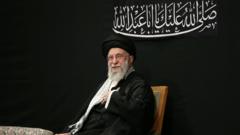What Did Iran's Supreme Leader Say in His First Public Appearance Since the Israel War?

Understanding the Recent Developments in Iran's Conflict with Israel and Khamenei's Public Appearance
The ongoing conflict between Iran and Israel has taken a new turn with the recent public appearance of Iran's Supreme Leader, Ayatollah Ali Khamenei. This appearance marks a significant moment amidst escalating tensions and military actions between the two nations, particularly following a series of events that have left the region on edge. As Khamenei re-emerges in the public eye, it is essential to delve into the implications of his reappearance, the context of the conflict, and the broader geopolitical ramifications.
The Context of the Conflict
The renewed hostilities between Iran and Israel began on June 13, 2023, when Israel launched a surprise attack targeting key Iranian nuclear and military sites. This marked a significant escalation in the long-standing tensions between the two nations. The attack was reportedly aimed at disrupting Iran's nuclear capabilities, which Israel perceives as a direct threat to its national security.
In retaliation, Iran initiated aerial strikes targeting Israeli positions. This cycle of violence rapidly escalated into a 12-day conflict that saw intense military engagements and heavy casualties on both sides. According to Iranian judiciary reports, more than 900 people were killed during the conflict, underscoring the severe human cost of the war.
Khamenei's Public Appearances during the Conflict
During the course of the conflict, Khamenei's public visibility was notably limited. His last major appearance before the recent mosque event was a series of pre-recorded video messages. Speculation arose regarding his safety and whereabouts, with rumors suggesting that he might have been hiding in a bunker due to the escalating threat posed by Israeli strikes.
Despite the concerns regarding his safety, Khamenei maintained his authority through televised addresses, emphasizing Iran's steadfastness against perceived external threats. On June 26, he publicly declared that Iran would not bow to Israeli pressure, even amidst calls from international figures, including US President Donald Trump, for a ceasefire.
Khamenei's Return to the Public Eye
On Saturday, just before the significant Shia festival of Ashura, Khamenei made a public appearance at a mosque in Tehran. This event was highly publicized by state media, showcasing his interactions with worshippers and supporters. Footage of this appearance highlighted the joy among his supporters, who expressed relief and excitement at seeing their leader after a period of uncertainty.
At the Imam Khomeini Mosque, named after the founder of the Islamic Republic, Khamenei engaged with senior cleric Mahmoud Karimi, encouraging him to lead the congregation in singing the patriotic anthem "O Iran." This song had gained popularity during the recent conflict, symbolizing national pride and unity amid adversity.
The Significance of Ashura and Its Observance
The timing of Khamenei's return coincided with the beginning of Muharram, a month of deep spiritual significance for Shia Muslims. Ashura, which falls on the 10th day of Muharram, commemorates the martyrdom of Imam Hossein, the grandson of Prophet Muhammad, and serves as a poignant reminder of sacrifice and resistance against oppression.
Khamenei's presence during this solemn period underscores his role as a spiritual leader within the Shia community, reinforcing his connection to the historical narratives that shape Iranian identity. His participation in the Ashura observances serves to galvanize support among the populace, especially in light of the recent conflict.
The Broader Geopolitical Implications
The Iran-Israel conflict does not occur in a vacuum; it is deeply intertwined with the geopolitical dynamics of the Middle East. The U.S. military's involvement, characterized by airstrikes on Iranian nuclear facilities, marks a significant escalation in the regional power struggle. This intervention has broader implications, especially concerning U.S.-Iran relations, which have been fraught with tension, particularly since the U.S. withdrawal from the Iran nuclear deal in 2018.
As the situation evolves, the international community watches closely. The conflict not only affects regional stability but also poses risks for global energy markets and international diplomatic relations. The potential for escalation remains high, as both Iran and Israel continue to assert their positions while navigating complex alliances and enmities.
Public Sentiment and the Role of State Media
The role of state media in shaping public perception in Iran cannot be overstated. Following Khamenei's recent appearance, Iranian state television encouraged citizens to share their reactions, creating a narrative of unity and resilience. This orchestrated display of support serves to reinforce Khamenei's leadership and the government's stance against external threats.
In times of conflict, state media becomes a powerful tool for fostering nationalistic sentiments. By portraying Khamenei as a steadfast leader, the Iranian government seeks to consolidate its power and maintain public morale, especially during periods of hardship and uncertainty.
Conclusion: A Turning Point in the Iran-Israel Conflict?
The recent events surrounding Khamenei's public appearance and the ongoing conflict with Israel highlight the complexities of Iranian politics and regional dynamics. As Khamenei re-establishes his presence in the public sphere, the implications for both domestic and international audiences are profound. The interplay between religious observance, national pride, and geopolitical tensions will continue to shape the trajectory of this conflict.
As the situation develops, the question remains: how will the international community respond to the ongoing hostilities, and what steps will be taken to avert further escalation? The outcome of this conflict may redefine not only Iran's role in the Middle East but also the broader balance of power within the region.
FAQs
What triggered the recent conflict between Iran and Israel?
The conflict escalated following Israel's surprise attack on Iranian nuclear and military sites on June 13, 2023, prompting Iran to retaliate with aerial strikes against Israel.
What was Khamenei's public stance during the conflict?
Khamenei consistently emphasized Iran's refusal to surrender to Israel and maintained a defiant posture in his video addresses during the conflict.
Why is Ashura significant in the context of Khamenei's appearance?
Ashura commemorates the martyrdom of Imam Hossein and holds profound spiritual significance for Shia Muslims, reinforcing Khamenei's role as a leader during this important period of mourning and reflection.
The recent developments in the Iran-Israel conflict raise critical questions about the future of the region. How will the ongoing tensions shape the political landscape, and what potential resolutions could arise in the face of such deep-seated animosity? #IranIsraelConflict #Khamenei #MiddleEastTensions
Published: 2025-07-05 21:51:06 | Category: world



